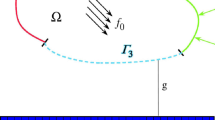Abstract
Three dimensional frictional contact problems are formulated as linear complementarity problems based on the parametric variational principle. Two aggregate-function-based algorithms for solving complementarity problems are proposed. One is called the self-adjusting interior point algorithm, the other is called the aggregate function smoothing algorithm. Numerical experiment shows the efficiency of the proposed two algorithms.
Similar content being viewed by others
References
Christensen, P.W., Klarbring, A., Pang, J.S., Strömberg, N.: Formulation and comparison of algorithms for frictional contact problems. Int. J. Numer. Methods Eng. 42: 145–173 (1998)
Mijar, A.R., Arora, J.S.: Review of formulations for elastostatic fricional contact problems. Struct Multiddisc Optim 20: 167–189 (2000)
Zhong, W.X., Zhang, H.W., Wu, C.W.: Parametric variational principle and its applications in engineering. Science Press, Beijing, China, 1997 (in Chinese)
Klarbring, A.: A mathematical programming approach to three-dimensional contact problems with friction. Comput Methods Appl Mech Eng 58: 175–200 (1986)
Leung, A.Y.T., Chen, G.Q., Chen, W.J.: Smoothing Newton method for solving two- and three-dimensional frictional contact problems. Int. J. Numer. Methods Eng. 41: 1001–1027 (1998)
Zhang, H.W., He, S.Y., Li, X.S.: Non-interior smoothing algorithm for frictional contact problems. Appl. Math. Mech. (English Edition), 25: 47–58 (2004)
Zhang, H.W., He, S.Y., Li, X.S.: A new algorithm for numerical solution of 3D elastoplastic contact problems with orthotropic friction law. Comput Mech 34(1): 1–14 (2004)
He, S.Y.: Studies on algorithms of complementarity problems and their applications in mechanics. [PhD dissertation], Dalian University of Technology, December, 2003
Pan, S.H., Li, X.S.: A self-adjusting primal dual interior point method for linear programs. Optim Methods Softw 19: 389–397 (2004)
Zhang, H.W., Zhong, W.X., Gu, Y.X.: A combined parametric quadratic programming and iteration method for 3D elastic-plastic frictional contact problem analysis. Computer Methods Appl. Mech. Eng. 155: 307–324 (1998)
Wright, S.J.: Primal-dual interior-point methods. SIAM Publications, Philadelphia, 1997
Li, X.S.: An entropy-based aggregate method for min-max optimization. Eng. Optim. 18: 277–285 (1992)
Chen, C.H., Mangasarian O.L.: Smoothing methods for convex inequalities and linear complementarity problems. Math. Prog. 71: 51–69 (1995)
Buczkowski, R., Kleiber, M.: Elasto-plastic interface model for 3D-frictional orthotropic contact problems. Int. J. Numer. Methods Eng. 40: 599–619 (1997)
Author information
Authors and Affiliations
Corresponding author
Additional information
The project supported by the National Natural Science Foundation of China(10225212, 50178016, 10302007), the National Key Basic Research Special Foundation and the Ministry of Education of China The English text was polished by Ron Marshall.
Rights and permissions
About this article
Cite this article
He, S., Zhang, H. & Li, X. Solving frictional contact problems by two aggregate-function-based algorithms. ACTA MECH SINICA 21, 467–471 (2005). https://doi.org/10.1007/s10409-005-0052-8
Received:
Revised:
Accepted:
Published:
Issue Date:
DOI: https://doi.org/10.1007/s10409-005-0052-8




